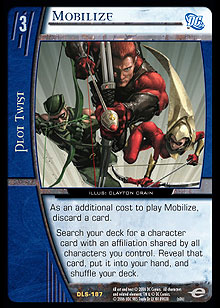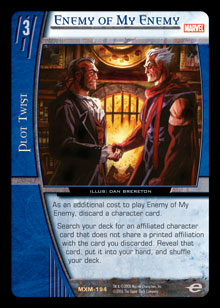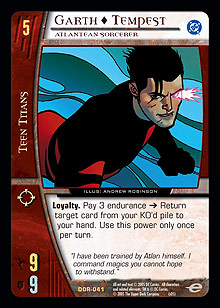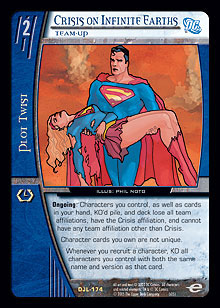 Welcome to the last fresh Theoretically Speaking of the year! In this article, I am going to tackle a subject that has received much recent attention: the topic is the raging debate between Enemy of My Enemy and Mobilize. I want to be up front—this is not an article glorifying UDE for “correcting” a potentially abusive card. Rather, the intent of this article is to help you sharpen your analytic skills when it comes to card selection in general and the benefits of a card like Mobilize in particular. By taking a closer look at this powerful card, we can learn how to make wiser card choices which in turn help us to create a better deck.
Welcome to the last fresh Theoretically Speaking of the year! In this article, I am going to tackle a subject that has received much recent attention: the topic is the raging debate between Enemy of My Enemy and Mobilize. I want to be up front—this is not an article glorifying UDE for “correcting” a potentially abusive card. Rather, the intent of this article is to help you sharpen your analytic skills when it comes to card selection in general and the benefits of a card like Mobilize in particular. By taking a closer look at this powerful card, we can learn how to make wiser card choices which in turn help us to create a better deck.
Marathon Man Part 2
A couple of months ago, I regaled you with a story from my $10K Columbus experience. Specifically, I am referring to the waitress who confused me for a marathon runner. Consider this your lucky day, because I was actually able to test my running skills and found that I am rather nimble on my feet.
It was the night before the Pro Circuit, and John Hall, Michael Barnes, Tim Batow, and I were driving to the airport to pick up my good friend Jeremy Blair. Unfortunately, there had been a miscommunication and Jeremy actually flew into a different airport. After much debate, we decided to head back to our car. As we started walking, Tim rushed past me, saying, “Race you!” I let him get a couple steps in front of me before I took off in a bolt of speed. John Hall later told me that he saw a big blue blur in front of him. I quickly whizzed past Tim, as he didn’t expect me to accept such a bold challenge. I had a short lead on him and was trying to pull away, but Tim had a decided advantage—being shorter, his legs are closer to the ground—so it was going to be a photo finish. As we approached the finish line, I leaned out with my chest and claimed victory, runner-style. It was later confirmed by both Michael Barnes and John Hall that I won the battle of the feet.
Later that weekend, Jeremy Blair—encouraged by my now legendary victory over Tim Batow—also challenged Tim to a footrace on the sidewalks of Anaheim. Many top pros such as Vidi Wijaya, Ryan Jones, and David Leader were around to witness this glorious event. Jeremy very carefully asked Tim if there were any special rules to the race, to which Tim responded in the negative. At this point they lined up, and then they were off. Tim easily grabbed the lead from Jeremy, who was quickly lagging behind. But Jeremy had a plan. As Tim was pulling away, Jeremy grabbed him by the backpack and picked him up, thus enabling Jeremy to run past my fast little friend. Tim immediately claimed foul, to which Jeremy slyly responded, “You said there were no rules.” While his victory was filled with treachery, together we proved one thing: don’t challenge a fat man to a foot race.
Battle of the Search?
I said earlier that this was not an attempt to thank UDE for (arguably) trying to balance the inequality that many people believe Enemy of My Enemy created. With that being said, Mobilize creates a new dilemma for card players. No longer will you hear the muffled cries of players lamenting the fact that they have no copies of Enemy of My Enemy. Instead, those cries will be replaced with mutterings of frustration as players try to determine which card fits best within their respective decks. Thankfully, that is what we are here for today. What follows is a brief look at both of the aforementioned cards and how to determine which card fits best within which deck type.
Metagame.com Writers at Odds?
 Recently, fellow Metagame.com contributor Steve Garrett did his own review of Mobilize. In that article, which you can find here, Steve said that he believed Mobilize to be better than Enemy of My Enemy. To every yin there is a yang, faithful readers—and apparently to every Steve there is a Shane—because I absolutely disagree with this statement.
Recently, fellow Metagame.com contributor Steve Garrett did his own review of Mobilize. In that article, which you can find here, Steve said that he believed Mobilize to be better than Enemy of My Enemy. To every yin there is a yang, faithful readers—and apparently to every Steve there is a Shane—because I absolutely disagree with this statement.
I want it to be clear that I am not saying that Mobilize is a bad card. This article is a testament to the potential I think the card has. I just personally believe that Enemy of My Enemy has and will continue to provide more utility for its cost than any other search card in Vs. System. What I mean is that Mobilize is restricted in the amount of characters it can search out unless you play Team-Ups, and even then playing more than two teams can prove dicey. Enemy doesn’t have that restriction and can play those tech characters with ease. Still, this doesn’t mean that Mobilize will always play second fiddle to Enemy. As we will see below, there will be times when Mobilize is actually a better choice for a deck. First, I want to cover some of the advantages and disadvantages that separate Mobilize and Enemy of My Enemy.
The Discard: Advantage Mobilize
This was mentioned in Steve’s article, but I would be remiss if I didn’t also mention it in my own. Steve is absolutely right that the discard requirement is one of Mobilize’s best features. Being able to discard any card in your hand rather than a specific type of card is always a good thing. I honestly believe that the character-restricted discard on Enemy of My Enemy adds to the utility of cards like Slaughter Swamp and Avalon Space Station. By utilizing a card like Mobilize instead, those card slots could potentially become more efficient in a deck.
The Card Pool: Advantage Enemy of My Enemy
The potential to use almost every character in existence (non-affiliated characters get no love) is nothing to scoff at. Unfortunately, Mobilize just doesn’t have the same kind of search power that Enemy of My Enemy offers. Mobilize essentially confines you to one team, or at the very least requires you to play multiple Team-Ups to use it effectively. Whereas with Mobilize you have to devote valuable card slots to get a bigger card pool to work with, Enemy of My Enemy provides that to you from the get-go. It gets the nod in this respect.
The Rest
Both cards have the same rarity and threshold cost, so that’s a draw. You can see that each card has its own strengths and weaknesses. There are many other ways to compare the two, but in the end, the decision will be based on what type of deck you are trying to play.
Choosing Is Half the Battle
Now that we know a little bit about the strengths and weaknesses of Enemy of My Enemy and Mobilize, it’s time to discuss how those strengths correspond to deckbuilding. This is probably one of the more difficult issues that the arrival of Mobilize created, because previously it was easy to say that Enemy of My Enemy was the best search card available. With that being said, let’s run down a few situations to help determine which search card would be best in a given deck.
The Mono-team Deck: Really, there isn’t much discussion here; Mobilize is by far the best choice. It’s really the only choice considering the discard restriction found on Enemy. I only mention this type of deck for redundancy, because there can be no debate here.
The Dual-team Deck: In this situation, the decision is not nearly as clear. Ever since Enemy of My Enemy was introduced, it was included in dual-team decks. But with the advent of Mobilize, which finally created a real choice (I say “real” choice because there were choices previously, such as team-stamped search effects or even the ineffectual Secret Origins or Weapon of Choice), the decision for this deck type is not as cut and dried.
The strength of Enemy seems to be in the fact that it can search out any character if you have the right discard. That strength tends to be downplayed more in a dual-team deck because you are limiting yourself to two teams, whereas Enemy can offer the most when you include multiple silver bullet characters. This is incredibly important in deckbuilding because if you are limiting the strength of Enemy (many characters over multiple teams), then you are limiting its utility (because you have fewer characters with different printed affiliations). We can conclude that Enemy of My Enemy is weaker in this type of deck but still not without value, because it still functions as a semi-efficient search card if you build your deck right. Generally, a good way to supplant the weakness of Enemy in these decks is to play another source of search to help alleviate some of the dependency on Enemy of My Enemy.
Let’s move over to Mobilize now. As stated above, having the right discard is not an issue, so that isn’t directly tied to the card’s strengths as with Enemy. Instead, this card’s strength is completely tied to the support cards—the Team-Ups—that are played with it. In order to even use this card, you must have a Team-Up online or have a contingency plan within you deck. When I refer to a contingency plan, I mean running at least one character of a given team at each drop so that you could potentially go mono-team if you miss your Team-Up. Of course, that’s something of an oxymoron; if you’d wanted to play a mono-team deck, you would have just played a mono-team deck instead of including a second team. Interestingly enough, though, back at Pro Circuit San Francisco my team did just that. We played a Checkmate character at every drop just in case we couldn’t get a Team-Up online. This helped to ensure that our Brother I Satellites would always have a use, and was an attempt to lessen missed drops. It seems that in order to make full use of Mobilize in a dual-team deck, Team-Ups are very important; therefore, finding ways to play Team-Ups or characters that give team affiliations (like Nenora) becomes very important. Unfortunately, making room for those cards can sometimes keep out bubble cards that could potentially improve the deck overall.
As you can see, there is no clear-cut answer in this situation regarding which search card would be most beneficial. Really, it’s a risk either way. By building your deck correctly, you can minimize that risk overall either by playing lots of Team-Ups to utilize Mobilize fully, or by playing other search cards to relieve the stress on Enemy of My Enemy.
The Three-Team or More Deck: Speaking in generalities, I believe that Enemy will always be the search card of choice in these types of decks. Making Mobilize efficient would require too much support in the way of Team-Ups; therefore, I believe that Enemy of My Enemy is the route to take on this adventure.
Hopefully, that brief analysis will aid you in determining which search cards have the most to offer in certain situations. Building a well-tuned deck is always one of the harder things to do in this game, and now that we have more choices that decision just got a lot more difficult.
How to Build a Better Machine: Mobilize on the Horizon
I have made it abundantly clear that I prefer Enemy of My Enemy to Mobilize, but I will be the first to admit that Mobilize is a better choice in certain situations. What follows is an examination of current and potential upcoming decks that could use the help that Mobilize so adequately provides.
Teen Titans
 Considering that this deck had very limited search, it seems as if Mobilize was tailor-made for the Teen Titans. The deck is completely mono-team, so the same-team restriction doesn’t hurt the deck at all. Also, with the help of Garth ◊ Tempest, discarding non-character cards becomes easier. The question then becomes one of what you take out of this incredibly tight deck to make room for Mobilize. The knee-jerk reaction is to cut Optitron, since Mobilize does what the location does, only better. If you cut that location, though, you lower the number of locations that you would have available for Terra, Tara Markov’s power. Overall, the inclusion of Mobilize in this deck seems like a no-brainer, but it will take a very inventive builder to determine exactly what needs to be cut to make space for its inclusion.
Considering that this deck had very limited search, it seems as if Mobilize was tailor-made for the Teen Titans. The deck is completely mono-team, so the same-team restriction doesn’t hurt the deck at all. Also, with the help of Garth ◊ Tempest, discarding non-character cards becomes easier. The question then becomes one of what you take out of this incredibly tight deck to make room for Mobilize. The knee-jerk reaction is to cut Optitron, since Mobilize does what the location does, only better. If you cut that location, though, you lower the number of locations that you would have available for Terra, Tara Markov’s power. Overall, the inclusion of Mobilize in this deck seems like a no-brainer, but it will take a very inventive builder to determine exactly what needs to be cut to make space for its inclusion.
X-Men
This team hasn’t seen much success on a competitive level, but I believe that Mobilize is just what the doctor ordered. This team has labored since the first set with an inadequate searcher, Cerebro. Yet all the key pieces of competitive play are there . . . minus the search card. They have great team-stamped plot twists (Duck and Cover, Eye of the Storm, and SNIKT!), great utility characters (Sunfire and Rogue, Energy Absorption), and big beaters (Wolverine, Logan and Colossus, Organic Steel). Mobilize could very well pull this team up out of obscurity and make it a Pro Circuit contender.
Arkham Inmates
I have always had a personal soft spot for this team, and now things are looking up for the crazy prisoners. First, they finally found some love in a team-up with the Brotherhood utilizing the Lost City / Avalon Space Station combo, and now Mobilize has come along and given them a much needed search card for those mono-Arkham decks. I don’t believe that a mono-Arkham build will be showing up in a competitive environment, but for a fun time I would definitely recommend throwing Mobilize in the mix and seeing what happens!
Mid-life Crisis?
When I first looked at Mobilize, I thought of the deck that FTN piloted at Pro Circuit Los Angeles. While the deck ran four copies of Enemy of My Enemy, it seemed to me that the card could prove inefficient once Crisis on Infinite Earths hit the field (because at that point, every character card gains the Crisis affiliation). Immediately, I contemplated Mobilize in Enemy’s spot. With Crisis on Infinite Earths giving all of your characters the Crisis team affiliation, you could easily use Mobilize for the same effect that Enemy offered the deck, but with less of a discard drawback and no need to worry about the inability to use a card like Enemy of My Enemy. Obviously, this is one of those times when Mobilize is actually better than Enemy of My Enemy.
 I honestly expect to see the Crisis on Infinite Earths / Mobilize combo show up in a lot of decks. It would work especially well in a Spider-Friends deck where you want to play multiple copies of Spider-Man, and also in other decks where you want to get around nagging loyalty requirements or just play multiple copies of the same character.
I honestly expect to see the Crisis on Infinite Earths / Mobilize combo show up in a lot of decks. It would work especially well in a Spider-Friends deck where you want to play multiple copies of Spider-Man, and also in other decks where you want to get around nagging loyalty requirements or just play multiple copies of the same character.
The biggest problem with this combo is being able to hit Crisis on Infinite Earths consistently. You always have Teamwork, but that card seems like a lot of hassle when you can just go with Enemy. Likewise, the X-Men also have a search in X-Corp: Amsterdam, which may be a better alternative to Teamwork. Unfortunately, the requirement of controlling an X-Men character may be too prohibitive to warrant any consideration. FTN seemed to hit the Team-Up somewhat consistently by using Dr. Doom, Richards’s Rival, so that may be a possibility. When you do that, though, the question then becomes whether there are better characters to drop on turn 3, such as the search-punishing Time Trapper from Future Foes or Dr. Light, Master of Holograms. When you limit a drop like that and devote it to search, you have to look and see what opportunity costs are associated with playing a character like Dr. Doom. Don’t get me wrong, Dr. Doom, Richards’s Rival is good, but I envision decks that will run the Crisis / Mobilize engine playing tech characters at each drop, and I know that there are several others that could be considered for 3 resource points.
What Have We Learned?
The biggest issue with this card is being able to determine exactly what each deck is trying to accomplish. I have often heard players saying that every deck starts with four copies of Enemy of My Enemy, but I don’t believe that is the case (at least not anymore). When you sit down to create a new deck, think about what you are trying to do. If you are looking to play a certain team, then Mobilize seems like it would be a great boon to your deck. If you want to create a dual-team deck, then the decision may not be as clear because of Enemy’s discard requirement. Finally, if you are looking to create a multi-team deck, Enemy of My Enemy seems to be the searcher you are looking for. Hopefully, that explanation will serve as a good rule of thumb as you begin to create new decks.
In the End
I hope you enjoyed this brief look into Mobilize and the impact it can have on Vs. System. While sometimes it is clear that Mobilize is the search card of choice, there are always those times where both Mobilize and Enemy of My Enemy could efficiently function in a deck. Hopefully, some of the aspects I covered today will aid you in deciding which card fits a particular deck the best. I hope you enjoy your holiday break and I will see you next year!
Shane Wiggans, one of the nicest guys with a tattoo sleeve, is also a member of Team Alternate Win Condition and uniformly rejects any race challenges by simply saying, “I choose not to run!” If you have any questions or comments for him, feel free to say hey at any event or email him at piercedlawyer@yahoo.com.